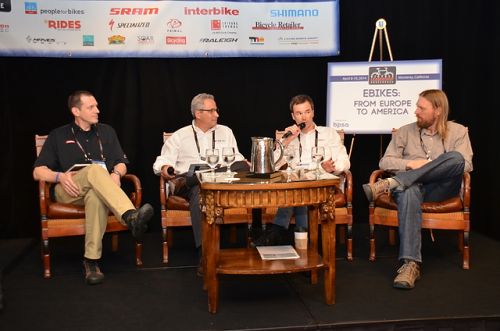MONTEREY, Calif. (BRAIN) — Fewer than 100,000 e-bikes were sold in the U.S. market last year, but a clear trend is emerging as more American consumers give them a second look.
And, more importantly, consumers who buy e-bikes are willing to pay between $2,000 and $3,000 for them thanks to dramatically improved batteries, motors and more modern designs.
That was the general consensus among panel members at the Bicycle Leadership Conference discussing the future of e-bikes sales in Europe and America. "Only five or six years ago, we struggled to sell them at $1,000 to $1,200," said Larry Pizzi, Currie Technologies' president.
But Pizzi noted that in 2012 the average price point was about $2,100. That's increased to about $2,500. "People are willing to spend," he added, in part because of the much-improved reliability of e-bikes.
The panel also made clear that it's impossible to build a reliable e-bike for $1,500. "It is not possible to spec a bike at the quality that is required for less than 2,000 to 3,000 euros," said Claus Fleisher, the managing director of Bosch's e-bike division.
And the price can only go up, predicted, Zach Krapfl, a consultant at GSD Global. "This $1,500 thing is not going to happen," said Krapfl, noting that the cost of commodities like lithium, rare-earth materials and aluminum are going up.
Nonetheless, Fleisher pointed out that e-bikes sales are on a sharp growth curve with the Netherlands, Germany and Switzerland leading the way. But growth in sales is uneven across Europe. Still, the growth rate is between 11 and 15 percent.
Those sales, however, appear to be cutting into traditional bicycle sales as European dealers embrace e-bikes. "Most successful retailers have adopted the e-bike, have multiple models, creating almost a boutique environment. You have to get people to try them and create excitement," Fleisher said.
As for margins, Pizzi said U.S. dealers expect to get 40 gross margin points on e-bikes sold for under $4,000. While in Europe, where the market is more mature, retailers work on around 28 percent margins, but they literally unbox them, set them on the floor and sell them within a day or so.
But Pizzi and Fleisher also noted that the early adopters for e-bikes tended to be older. They were interested in mobility, but riding a regular bicycle had become more difficult for them.
But with higher performing systems, better designs and a growing demand among consumers living in dense urban areas, that trend is changing. "The trend we see now is going from the old to the young," Fleisher said.




